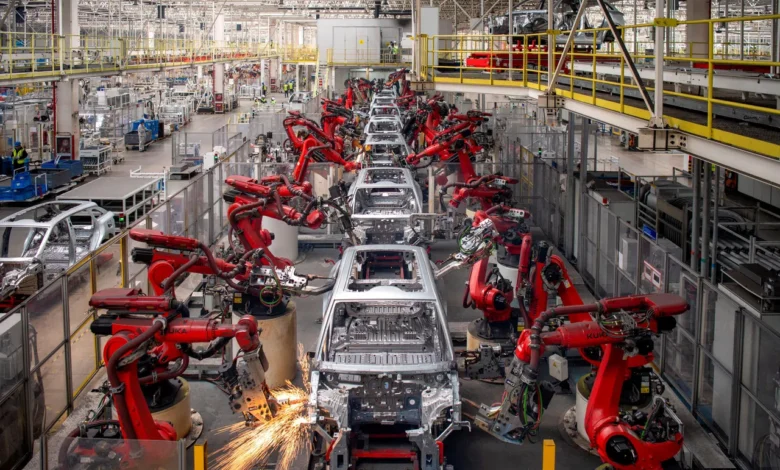China’s factory glut alarms the world but there’s no quick fix

THE groundswell of complaints about China’s factory output keeps getting louder, but there’s no sign Beijing is ready for fixes that might backfire on its vulnerable economy.
This week European Union leaders, who are threatening tariffs on electric vehicles (EVs), were the latest to scold China about overcapacity. Before she met visiting President Xi Jinping, the bloc’s chief Ursula von der Leyen said she’s hoping for action in the “short term”.
She will likely be disappointed. China did announce proposals on Wednesday (May 8) to slow expansion in the battery industry, but they are not binding. Meanwhile the state planning agency last week published a four-part rebuttal of claims that the country has too much capacity to make clean-energy products. It said the Chinese industry is competitive thanks to innovation, not subsidies.
That’s become Beijing’s standard line about high-tech industries such as EVs and solar panels. They are crucial to Xi’s blueprint for reviving the economy – which is why China probably will not stop supporting them, however much it’s urged to. They are strategically important for other countries too, which is why trade barriers are going up.
But China’s trade partners – including friendly ones such as Brazil – are also raising objections about all kinds of products lower down the value chain, from steel and petrochemicals to excavators. In many of these areas, surpluses emerged as an unwanted side-effect of the real estate slump weighing down China’s economy.
Beijing has not figured out how to halt that slide yet, except by turning to high-tech as an offset, so both types of over-production are set to persist.
GET BT IN YOUR INBOX DAILY

Start and end each day with the latest news stories and analyses delivered straight to your inbox.
“There is no single, quick fix for China’s overcapacity challenge,” says Frederic Neumann, chief Asia economist at HSBC Holdings. In clean energy the root cause is China’s “robust investment”, he says, while in more traditional industries the problem is weak demand, “especially from faltering housing construction”.
What’s ultimately needed, according to Neumann, is “a two-pronged approach” to balance supply and demand, which involves stabilising China’s housing market and helping consumers to spend more.
But that’s a big ask – as even some of China’s strongest capacity critics admit.
US Treasury Secretary Janet Yellen’s recent visit was dominated by the issue. Her team repeatedly chided Beijing for steering state funds into key industries, propping up money-losing companies and flooding world markets with exports that threaten the livelihood of local firms.
The US view is that China should rely more on demand from its own consumers, and less on the rest of the world. Yellen acknowledged the scale of that challenge. “This is a complicated issue that involves their entire macroeconomic and industrial strategy,” she told reporters in Guangzhou. “It’s not going to be solved in an afternoon or a month.”
Right now, far from being ready to shoulder more of the burden of driving growth, Chinese households and local governments are tightening their belts after the housing crash.
With domestic demand weak, the industrial capacity utilisation rate dropped last quarter to the lowest since the pandemic hit in early 2020. Factories are pivoting to overseas markets, exports have soared and prices plunged.
The solar panel industry is one case where there’s a glut, after a massive expansion led to a price war and a collapse in profitability.
In autos, the picture is more complex. Capacity use dropped sharply in the first quarter of this year, but major exporters of EVs – such as BYD and Tesla – have been running at higher levels than the industry overall, according to estimates from JSC Automotive. That points to a growing number of idle factories which used to make petrol cars and got caught out by China’s rapid switch to EVs.
One fix for the EV tensions may be for Chinese firms to start producing in other countries.
Japan’s economic standoff with the US in the 1980s eased after Japanese carmakers invested in American plants. Chinese firms are starting to follow that path in Europe, South America and Asia, with backing from Beijing. The Communist Party’s main decision-making body said last week it would “support private enterprises in expanding overseas markets”.
Xi’s European itinerary included stops in Hungary, where BYD plans a factory – and France, where Prime Minister Bruno Le Maire said his country would welcome one too.
But that’s a longer-run strategy. BYD says it will take three years to start producing in Hungary. And it may not work in the US, where there’s growing hostility to any Chinese investment.
In older industries, there’s a precedent from almost a decade ago when China tried to deal with massive overcapacity in steel and aluminium. It forced the industry to rationalise and closed down less-efficient producers.
Yellen and her Treasury colleagues say Beijing should take a similar profit-focused approach to industries now.
“The share of money-losing firms in China is as high as it’s been in decades,” Jay Shambaugh, undersecretary for international affairs, said last month. “You have got firms that are not really responding to what the market will bear.”
But closing firms and cutting jobs in a weak economy is a high-risk move. What’s more, China’s policies of the 2010s did not lead to a substantial decline in output. And lately, the problem has reared its head again, with steel exports surging to an eight-year high and triggering complaints worldwide.
In all of this, the underlying issue is that China’s state-led expansion of manufacturing isn’t matched by growth in consumption at home, says Camille Boullenois, an analyst at Rhodium Group.
“There are only a few ways companies can deal with it: they can under-utilise their production capacity, keep goods in inventories, export more, or import less,” she says. “We are seeing all these effects at the moment in China.” BLOOMBERG





